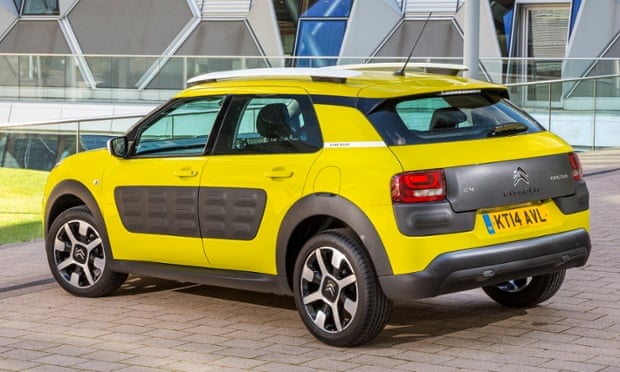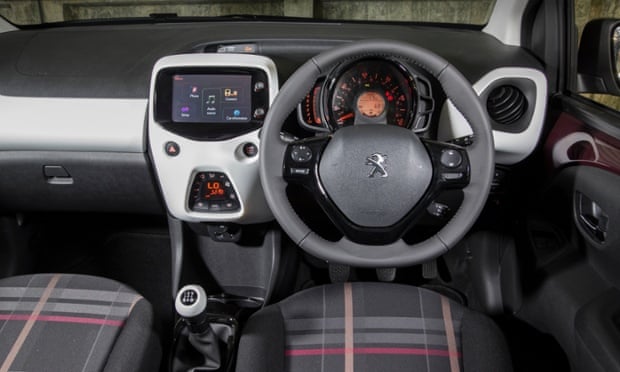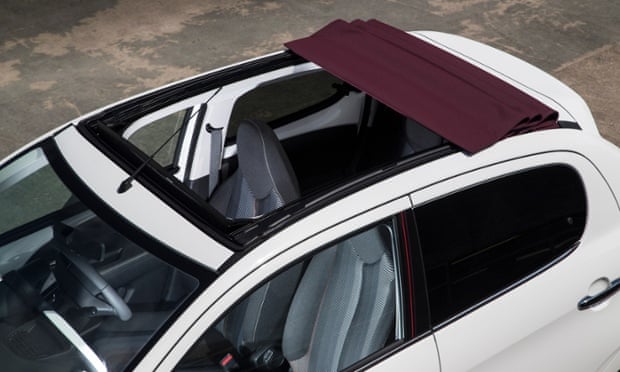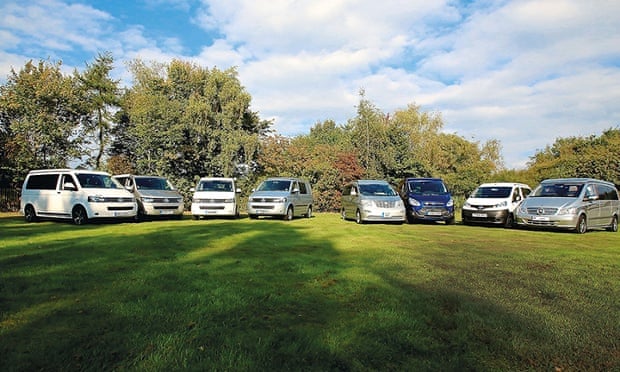Citroën Cactus: <b>car review</b> | Martin Love | Technology | The Guardian |
- Citroën Cactus: <b>car review</b> | Martin Love | Technology | The Guardian
- On the road: Kia Soul – <b>car review</b> | Technology | The Guardian
- Peugeot 108: <b>car review</b> | Martin Love | Technology | The Guardian
- Fiat Panda 4x4: <b>car review</b> | Martin Love | Technology | The Guardian
- 2015 Mazda3 | new <b>car review</b> - AutoMiddleEast.com
- 2015 Honda CR-V <b>review</b>: Tech and safety features of $60,000 <b>...</b>
| Citroën Cactus: <b>car review</b> | Martin Love | Technology | The Guardian Posted: 22 Nov 2014 10:00 PM PST Price £12,990  Prickly heat: the new Cactus comes complete with protective Airbumps on each door. Photograph: PR Prickly heat: the new Cactus comes complete with protective Airbumps on each door. Photograph: PR I know what you're thinking. "Why has that weird car got Lego stuck all over its doors?" Or: maybe it's a rubber shower mat or chocolate? In fact it's thermoplastic polyurethane filled with air capsules. It absorbs impacts, like tough bubblewrap. Citroën calls it Airbump technology. The stuff doesn't dent and ding. You bash it, it protects your car and then pops right back out. It's not to everyone's taste. My wife thought a car with dents and scrapes all over it would still look better than the Citroën Cactus and, she wondered, what exactly is the difference between plastic that protects your car and a "bumper"? Fair point. But for all those narrow-minded grumps, there will be many who'll take this unusual car to their hipster hearts. So much modern motoring design follows the same tired, dull, play-it-safe template it's a wonder that we don't all doze off in traffic jams. Anyone trying something new should be applauded. And the Cactus is certainly something new. Taking its starting point as the already likeable C4, Citroën polled its customers and found they wanted "more useful technology, reduced costs and more design". And, lo, the Cactus is what they got. It's techy, good value and it's got Airbumps…  Inside story: the funky interior of the new Cactus. Photograph: PR Inside story: the funky interior of the new Cactus. Photograph: PR The focus for most of its clever tech is the fully digital touchscreen which sits on the dashboard like an iPad casually propped up on its side. Through this device you access all your music, navigation, parking, phone, photo and social needs. The next generation of cars is being designed for a generation of drivers who want to feel connected all the time, and in the Cactus you can browse apps, check out TripAdvisor and plan your next food and fuel stops while doing that other thing you do in cars… you know, drive. With prices starting at under £13,000 for a comfortable five-seater with a decent boot and plenty of driver aids, the Cactus is certainly affordable. Factor in the incredible fuel efficiency offered by the latest-generation of low-revving Euro 6 engines and your bank account soon starts to relax. Spend a couple more grand on the range-topping 1.6 BlueHDi eco car and you'll get an amazing 83.1 miles to the gallon.  Rear view: the sculpted back end. Photograph: PR Rear view: the sculpted back end. Photograph: PR There's loads of other clever stuff, too. The panoramic sunroof, for instance, has advanced heat protection which keeps warmth in and UV rays out. It means there's no need for a sun blind, which in turn gives you more headroom, and also does away with the price and weight of an electric motor to open and close it. Then there's the design. As well as those Airbumps, the car has a host of bold and dynamic flourishes. Inside, everything is conceived around straight edges and square shapes. The instrument panel is a block that looks like a 70s radio, its boxy retro numerals glowing in the dark. The front seats have sharp corners, while the back row is a single bench. Door handles are leather straps and the glove compartment has been replaced with a roomy top box with two horizontal straps, like a posh picnic hamper. It all feels very hip. Maybe it will inspire other manufacturers to be less boring in the future. Email Martin at martin.love@observer.co.uk or follow him on Twitter @MartinLove166 | |||||||||||||||||||||||||||
| On the road: Kia Soul – <b>car review</b> | Technology | The Guardian Posted: 21 Nov 2014 10:00 PM PST Kia Soul: 'Inside it's a little less abrasive to the eye.' Photographs: Simon Stuart-Miller for the Guardian I am standing in an underground car park, contemplating the Kia Soul. I pace about and size it up, view it from every angle, and still I cannot shake the thought of how unbefittingly it is named. One thing it doesn't have is soul. The story runs that the Soul began when a member of Kia's design team in California was sent to Korea to help conjure up a new vehicle. Riveted by a TV programme about wild boar, he duly drew a sketch of a boar wearing a backpack, which in turn led to the idea of a rectangular car with a sloping roof. It would be the perfect marriage of "strength and capability" that would appeal to "hip urban youths". What stands before me in the car park, in a blistering shade of Heinz tomato soup, looks more like a hybrid of a Playmobil fire truck and a Royal Mail van. It's very tall and boxy and basic-looking, and there isn't a hint of swine about it. The original Kia, launched in 2008, sold well in the US, but miserably in Europe. This new version looks to address this discrepancy. It has better suspension and improved steering, and its famously noisy cabin has been hushed by greater sound insulation. It's also a little longer, wider, sturdier in the frame. More unwisely, it has acquired an outlandish number of black trims – all over the back, around the wheel arches and the sills, like the contrast piping on a cheap sofa. Inside, it's a little less abrasive to the eye and comfortably furnished, with a large amount of headroom and upper body space – so much that it feels oddly airy at first. But it's heavy – 1.5 tonnes, it was never going to tread lightly. That extra chunkiness makes it less economical, too: with the top-end petrol version, running costs can be comparable to a full-sized SUV, and then there's the added tax brought by its startlingly hefty CO2 emissions. As we scuttle around in it later, I'm surprised by how little it leans for such a lofty car, but also how jumpy it feels over potholes and, despite its improvements in sound insulation, how noisy it remains. Truthfully, I'm a little embarrassed by its lumbering hulk. At traffic lights, I want to mouth through the window to anyone alongside me: "I did not buy this car." Who would buy this car? Maybe someone very tall and broad-shouldered who needs a lot of boot space and has a thing for wild boar. It might appeal to the older or more cautious driver – reassured by its heaviness and perfectly content with its pootling demeanour. But certainly no hip urban youth, and no one with even a hint of soul.  Price From £17,500 • Follow Laura on Twitter | |||||||||||||||||||||||||||
| Peugeot 108: <b>car review</b> | Martin Love | Technology | The Guardian Posted: 08 Nov 2014 10:00 PM PST Purple reign: the new 108 is packed with sumptuous extras and nice details. Price £8,245 Remember your first car? Mine was a Renault 5 with foreign plates. Rust spread like impetigo round its battered grille; moss grew in the window seals. It had no heating, no stereo, one windscreen wiper and, towards the end of its short but joyous life in my hands, no starter motor. We had to jump it every time… But it was wheels and freedom and… I don't think I've ever loved a car as much. I've been thinking about first cars this week as I have been driving the Peugeot's new 108 – a small city car aimed firmly at young people. The car was launched this summer and more than 5,000 have already been sold in the UK, almost all to young people who have never owned a Peugeot before. On average the new owners are seven years younger than the people who bought the outgoing 107. Manufacturers value these customers highly because, as car buyers, we are remarkably loyal. The hope is that if you snare a young driver he or she will stay with you for life, slowly working their way up through the various models in the range. (It doesn't always work like that – I've never owned another Renault!)  Inside story: the 108's funky interior is orientated around its connectivity. Inside story: the 108's funky interior is orientated around its connectivity. With its sharp looks and plush options, including a fully retractable fabric roof, Peugeot's 108 feels a bit too posh to be aimed solely at youngsters. Learning to rough it with an unreliable rust bucket is an important part of their education. How else are they going to learn an appreciation of the finer aspects of motoring – like not sweating at red lights as you wait for the inevitable stall; the dreadful slow bump of a dying battery. The 108 is a lot more sophisticated than the popular 107 that it replaces. Ivo Groën, the car's designer, was set the goal of giving the 108 a more premium and upmarket feel, as well as differentiating it from Citroën's C1 (which is cute) and Toyota's Aygo (trendy). All three models share the same underpinnings and virtually identical interiors, so it is only the exterior dressing and the badge that buyers have to choose between. These cross-brand alliances are quite common and the unusual pairings you stumble across in the motoring world would make even a veteran swinger raise their eyebrows: Renault and Nissan; Fiat and Chrysler; BMW and Toyota… it's all going on. Groën set about his task by creating a car with a chic "about town" character. At the car's launch, he explained his thinking: "The 107 had a very cab-forward 'mono-volume' silhouette… We wanted to give the 108 more of a nose and the powerful feeling that comes with that. We wanted to reduce the glass and increase the sculpting of the body, and at the same time give it a timeless elegance." Well, there you are…  Blue-sky thinking: the 108 has a retractable fabric roof. Blue-sky thinking: the 108 has a retractable fabric roof. The nose he developed is dominated by the same "floating grille" as seen on the 108's bigger sisters the 208, 2008 and 308 – they do say noses run in families. The grille is flanked by a pair of smart bifocal projector headlights, while round the back the group's "lion claw" lamps provide another link to the rest of the Peugeot range. Two engines are available – a 68PS 1-litre three-cylinder or an 82PS 1.2-litre three-cylinder petrol. Both are efficient and economy is up to 74.3mpg. But the 107 was cheap to run, too. The big difference here is that the 108 is a pleasure to drive. The three-cylinder engine means it makes a strange "thrum", but you soon get used to it. I drove more than 200 miles in a day – taking my daughter back to university, which seemed a fitting journey for a car aimed at young people. It handled the motorway brilliantly and was small enough to dance through Bristol's gridlocked streets and squeeze into a tiny space outside her student digs. Other than being small, cheap and available in dozens of personalised colour combinations, the most obvious youth-centric aspect of the 108 is its connectivity. In 2005 when the 107 was introduced no one had a smart phone, but, the 108 is all about your phone. A seven-inch touchscreen in the centre of the dash can be linked for all your music, media and maps. It feels like the heart of the car in some ways, as if the 108 is simply a large phone holder. Not so much Motion & Emotion, in Peugeot's famous tagline, as Motion & Emoticon. A trip down Lego lane Rush hour: Lego cars take to the capital's streets. Rush hour: Lego cars take to the capital's streets. Lego and cars comes together once again as the new Shell V-Power Lego Collection arrives in petrol stations across the land. The range includes a Ferrari F138, Ferrari 250 GTO and Ferrari F12berlinetta. You may not be able to afford the real thing, but these little racers will only set you back £1.99 when you buy £30 or more of Shell's performance fuel Shell V-Power Nitro. Peta Todd in the Wales Rally GB Peta Todd with Tony Jardine Photograph: PR Peta Todd with Tony Jardine Photograph: PR She may be married Mark Cavendish, one of the world's fastest men on two wheels, but no Peta Todd is getting closer to the action when she competes as a co-driver in the Wales Rally GB, Britain's round of the World Rally Championship, which gets underway on Thursday 13 November. Peta will be racing with Tony Jardine. Speaking ahead of her WRC debut, Peta said: "Mark is ultra-successful; we know that, his trophies are all over the house. I've decided it's time to win a few trophies of my own, by taking on my own sporting challenge. Once he knew that I was taking on a navigators role in a rally car at 120mph in the World Rally Championship he was 150% jealous, he has already tried to push me out of the seat. I told him to stick to two wheels!" To experience the action yourself at Wales Rally GB, tickets can be purchased at walesrallygb.com or via the ticket hotline 08448 472251 Email Martin at martin.love@observer.co.uk or follow him on Twitter @MartinLove166 | |||||||||||||||||||||||||||
| Fiat Panda 4x4: <b>car review</b> | Martin Love | Technology | The Guardian Posted: 15 Nov 2014 10:00 PM PST Price £14,295 I have a confession to make. I've lied to a priest. Father Dominic recently sent me an email from his church in Italy, in a village near Cortona, asking for advice about a car. I imagined him tapping away in the crypt of the ancient chapel, a guttering candle throwing shadows across the stone floor, the organist practising next door, a wild boar piglet snuffling in the straw at his feet… Anyway, the padre was after a vehicle that was both rugged and reliable at coping with the dreadful rural roads yet small and tidy enough to squeeze along the hill town's medieval streets. I figured he'd also need something Italian and that Pope Francis would approve of. Bugatti's Veyron and Maserati's Ghibli were out on the grounds of frugality and celibacy. There seemed to be only one candidate: Fiat's Panda 4x4. The problem was that I'd never tested one. Could I really recommend a car I'd never driven – to a priest? I figured God would understand. Weeks later I received an ecstatic email from the padre. He loved it and now wanted me to recommend a car for his mother… So I thought I'd better find out what Father Dom liked so much about the Fiat Panda 4x4. It first appeared in 1983. Back then, as the world's first small car to have all wheels driven, it was years ahead of its time. It shares the same boxy shape of the standard Panda, but the 4x4 is so much more than just a more agile Panda (if such a creature exists). It comes with steel bash plates to protect its delicate underside, chunky bumpers and high wheel arches to cope with its raised suspension, and a revolutionary electronic rear differential system that means it can roam wherever you want. Don't think of it as a weedy Land Rover – it's more a giant quad bike with a roof.  Funky and fun with comfort: the Fiat Panda's interior Funky and fun with comfort: the Fiat Panda's interior This model is the third generation of the car. It's as fun and funky as ever, but it now also has the quality, comfort and technology of a much more serious vehicle. It's hard to get your head around just how multi- talented it is: it seats five yet has a tiny road print; it's short and narrow yet has a high roof, so it feels roomy; its small engine is economical yet it's powerful enough to tow a caravan; it's built for rough tracks yet feels very at home on motorways. Under the bonnet there's a choice of an 875cc TwinAir Turbo or a 1.3-litre MultiJet 2 turbo diesel. Both come with start-stop technology and an indicator which tells you when to change gear in order to achieve the best economy. The car comes with "Dualdrive" electric power steering with a City function which means at slow speeds the steering is much lighter. An option you might want to invest in is a low-speed collision- mitigation system usually found only in much bigger cars. This reads the road ahead and when it detects an obstacle it slams on the brakes automatically. If you don't think you'll be needing the four-wheel drive system, the Panda Trekking model is for you: it has the same engines and chunky looks but is 2WD and £1,500 cheaper. Having spent a week with the Panda, I found it reliable when the going got tough, cheap to run and a lot cooler than you might guess… Everything you would hope to find in your local priest.  Eight of the best: the motorhome line-up. Photograph: PR Eight of the best: the motorhome line-up. Photograph: PR Earlier this summer I test drove the Wellhouse Ford Terrier SE and loved it. But I'm not the only one who has fallen for its charms. Which Motorhome, the UK's number one magazine for motorhome testing, has just completed an extensive group test of eight campervans, featuring four VW T5-based campervans and four key non-T5 alternatives. The VW T5 campervans featured were Bilbo's Space, CMC Reimo Trio Style White Line, Hillside Birchover and the Volkwagen California SE. The other campervans tested were the Auto-Sleeper Wave (based on Mercedes Vito), Hillside Dalbury Action (based on Nissan NV200), Wellhouse Alphard (based on Toyota Alphard) and Wellhouse Terrier SE (based on the Ford Transit Custom). The test team looked at campervans that gave almost equal priority to everyday use as they do to living outdoors. They were looking for compact dimensions and the ability to get under car park height barriers, plus minimal camping facilities including a small cooker, fresh water supply, beds and storage. The winner? Wellhouse's Ford Terrier SE, of course. Editor, Peter Vaughan said: "The VW T5 has dominated this sector to the degree that many customers simply say that they are looking for a Volkswagen camper. So for the Ford-based Terrier to come out on top speaks volumes about how good this campervan is." Which Motorhome is available from all good newsagents on the second Thursday of every month. For more information, go to which-motorhome.co.uk. Digital issues and subscriptions are available at pocketmags.com. Email Martin at martin.love@observer.co.uk or visit theguardian.com/profile/martinlove for all his reviews in one place. Follow Martin on Twitter @MartinLove166 | |||||||||||||||||||||||||||
| 2015 Mazda3 | new <b>car review</b> - AutoMiddleEast.com Posted: 25 Nov 2014 12:24 AM PST Looks Mazda had altered the styling of its Mazda3 in 2014 drastically and in 2015, it retains all the elements that made it an outright stunner. The large black grill with slits in the lower bumper add more down-force giving the car a sportier vibe over its tamer rival, the Toyota Corolla. Feels The first thing you notice upon entering the cabin, is the neat center console and how it funnels downwards to meet with the gear lever. Plenty of cup holders scattered around for the on-the-go caffeine-oholics. The A/C knobs are well planted, however, cheaper plastics are used for the no frills model. The Mazda3 can seat 4 adults reasonably comfortably, however it's important to keep in mind that the sloping roof shaves off a few inches of headroom. Engineering In terms of tech, the 2015 Mazda3 packs in an interesting i-ELOOP regenerative braking system. Ideally, it harnesses the kinetic energy during deceleration, re-using it as electrical energy. Typically, about 10% of an engine's power is converted into electricity and used to power the car's electrical systems. With i-ELOOP regenerative braking system generating electricity, 100% of the engine's power can be used for propulsion, creating even better fuel efficiency. What's on offer? The 1.6L inline 4-cylinder engine has an output of 105 HP and 145 NM of torque. The 4-speed Activematic transmission offers fully automatic operation or the responsive feeling of pseudo-manual gear shifting. The base Mazda3 sedan starts at AED 63,000 and is equipped with one-touch power windows for the driver's side, power steering with tilt & telescopic adjustment, 60:40 folding seats, multi-information display, and dual front airbags. Enter 2.0 litre territory and you'd have to be willing to shell out either AED 88,000 for the sedan, or AED 90,000 for the 155 horsepower hatchback variant. Summing it… The 2015 Mazda3's 1.6L doesn't exactly pack a lot of punch under the bonnet. Rated at only 105 horsepower, it lacks performance when compared to the Nissan Tiida's 116 horsepower. But opt for the 2.0 litre version, and there's a decent amount of kick found with 155 horsepower and 200 Nm of torque. Specifications
| |||||||||||||||||||||||||||
| 2015 Honda CR-V <b>review</b>: Tech and safety features of $60,000 <b>...</b> Posted: 21 Nov 2014 05:30 AM PST  Imagine driving a mainstream Honda with the tech and safety features of $60,000 luxury cars. It's here now at half the luxury car price. Adaptive cruise control, self-steering lane keeping, collision mitigation and pedestrian braking are all offered on the 2015 refresh of America's best-selling SUV. The CR-V is also safer, more fuel-efficient, and the cabin is more luxurious this time around. The CR-V center stack is a work in progress, however. Small buttons, missing volume and tuning knobs, and no single-touch access to navigation and other functions could be a turnoff for buyers and may cost the CR-V points on customer satisfaction surveys. Regardless, Honda is helping make the most important new driver assistance technologies available on mass production cars. Over time, this reduces accidents and fatalities. Honda Sensing: Sensor Fusion for safety, not shaving
Honda calls it Sensor Fusion, again with apologies to Gillette and its razor lines. On the CR-V, this gives you adaptive cruise control that works down to 20 mph, lane keep assist and lane departure warning, and collision mitigation braking for both pedestrians and cars. The Honda Sensing umbrella also encompasses LaneWatch, Honda's existing passenger-side-mirror camera that comes on all but the entry trim line. You see the view on your blind spot in the 7-inch center stack display with three horizontal rangefinder lines and three zones that indicate no go, marginal, and okay to switch lanes. It's drop dead simple to understand and use, either by tapping the end of the turn signal stalk (always on) or the right turn indicator (on until the signal shuts off). The driver side gets a convex edge to the door mirror. Honda Sensing does not include rear parking sonar, rear cross traffic alert, or active blind spot detection, which require sonar sensors. Honda does sell rear sonar as a pricey dealer accessory but it's $530 plus a couple hours labor at $100 an hour. Honda Sensing will have more features on future Hondas and Acuras. Surround view cameras, active blind spot detection, and cross-traffic alert cameras would be likely additions. CR-V on the road: A good little SUV gets betterForget for a moment that our site is ExtremeTech and tech is what we care most about. The Honda CR-V is the nicest vehicle in the category of compact SUVs (meaning vehicles about 180 inches or 4570 mm long and two rows of seats). Nearly 2.5 million compact SUVs are sold each year in the US. The CR-V is the No. 5 best-seller among all cars and trucks, behind only three pickups and the Toyota Camry. This is the category with the Ford Escape, No. 8 in sales, the Toyota RAV-4, Chevrolet Equinox, Hyundai Tucson, Mazda CX-5, Nissan Rogue, and our reigning Editors' Choice Subaru Forester. Ford has the better interior and the liftgate that opens when you walk up, Nissan stuffs in a third row of seats and surround view cameras, the Mazda is the most fun to drive, and the Toyota is all-round competent. If you sum up handling, ride quality, fuel economy, interior space, safety and price — everything aside from tech — the new Honda CR-V is the best of the bunch.
The cabin is big for a compact SUV. Some mid-size luxury sedans have less rear seat room than the CR-V. Honda stepped up the fit and finish noticeably with the refresh of the fourth generation CR-V although the cockpit is still not in the same league as, say, an Audi A3 (Audi is the benchmark and costlier). The ride is quieter. There is one engine choice, a 185 hp four-cylinder with direct injection, no turbo, that Honda calls "Earth Dreams," and a continuously variable transmission (CVT) replacing Honda's dated five-speed automatic. It pushes Honda from mid-pack to the top of the fuel economy ratings. The all-wheel-drive model gets 26 mpg city, 33 mpg highway, 28 mpg combined. The front-drive CR-V is 1 mpg better: 27/34/29. Acceleration is adequate, around about 9 seconds to reach 60 mph. Torque, the grunt that gets you going, increases by about 10 percent and at lower rpm, so the CR-V feels quicker than it is. Next page: The CR-V's technology…
|
| You are subscribed to email updates from car review - Google Blog Search To stop receiving these emails, you may unsubscribe now. | Email delivery powered by Google |
| Google Inc., 1600 Amphitheatre Parkway, Mountain View, CA 94043, United States | |








No comments:
Post a Comment